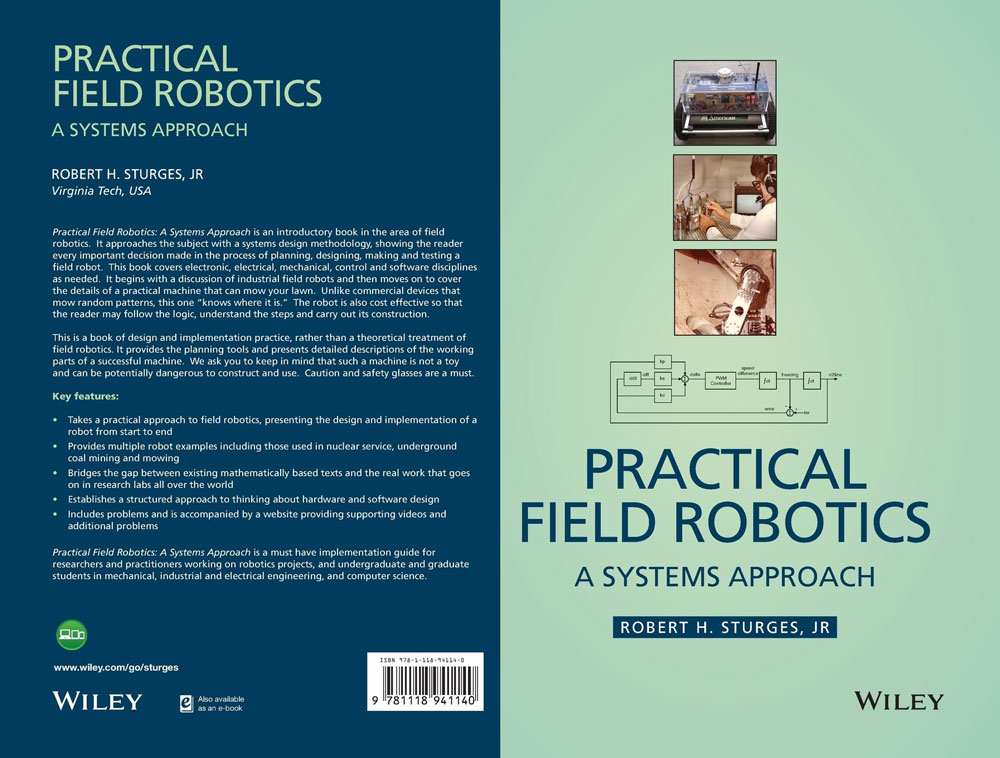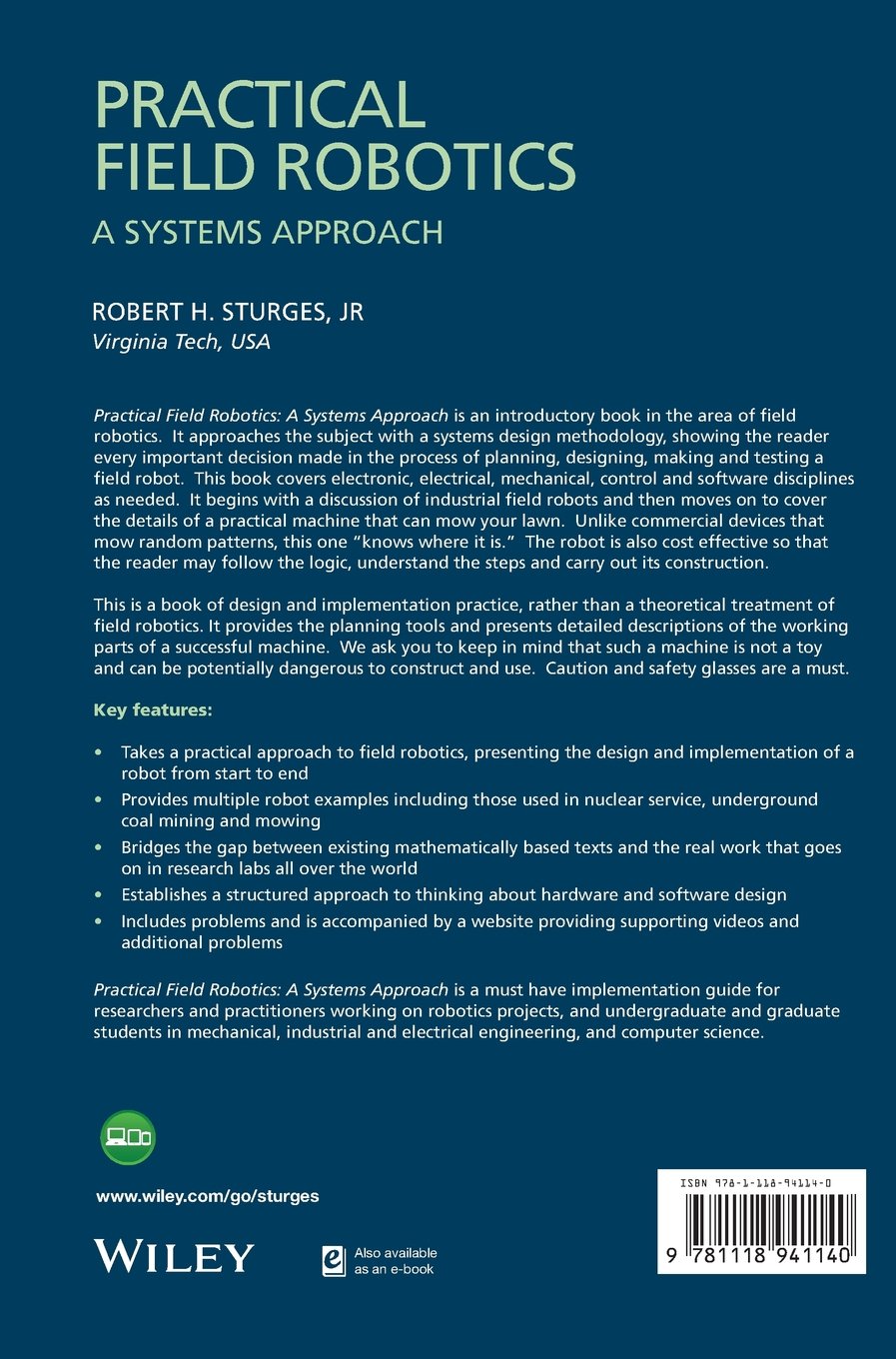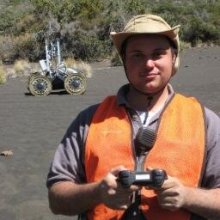
Robohub.org
Book Review: ‘Practical Field Robotics’ by Robert Sturges
 Practical Field Robotics: A Systems Approach by Robert H. Sturges, Jr. from Virginia Tech is an interesting book about how to design a field robot from a high level systems approach, and how to build a robotic lawnmower.
Practical Field Robotics: A Systems Approach by Robert H. Sturges, Jr. from Virginia Tech is an interesting book about how to design a field robot from a high level systems approach, and how to build a robotic lawnmower.
This book has two primary sections. The first part of the book looks at three different example robotic systems from the domains of nuclear service robotics (teleoperated), mining robotics (large and autonomous), and a grass cutting robot (cheap consumer product). The second part of the book focuses on moving beyond those designs to cover the detailed software and systems that make a robot work.
The author presents a series of layers that can be applied to systems to characterize and guide a design. These layers are a way to guide the definition of requirements in order to build a robotic (or any other) system.
- Field Environment – This is where the operating environment needs to be defined. These items can include: thermal, radiation, humidity, site layout, terrain, water, dimensions of interest, etc.
- Field Work – This includes the tasks that the robot needs to complete in the environment from above.
- Equipment Requirements – What constraints need to be placed on the robot due to the layers above. For example in a reactor building you can not use halogens on your robot/equipment.
- Conceptional & Operational Designs – This layer is where you can really spend a lot of time. This is where you take the requirements and constraints that you defined in the above layers and actually create the high level details for the system that you will build. This can include creating concept of operations, figuring out what a mechanism should be, and determining your high level design.
- Safety & Reliability – Once you have a basic design you need to evaluate the safety and reliability of the resultant design. This applies to the robot, the operators, the environment, etc. Note that this comes before the detailed design is completed.
- Detailed System Design – <system> – Once you have a basic design and you make sure it will be safe and reliable you are finally able to create the detailed design that you will build. You can have multiple instances of this layer for each of your various systems.
One thing I ignored above is that the author discusses creating free body diagram’s (FBD) to help design the above systems.
The second half of the book moves on to the next levels of design. For example when performing the exercises above you create an FBD that has a block for Send Sound. The next level is detailing that block; you can create an FBD of that step alone. The author expands this by discussing the electronics, software (assembly style code) and how to set parameters in order to execute a Send Sound block. The author does this for several different types of functions. In practice the second half of the book is just a detailed view into how they built their robotic lawnmower project.
The author says several times that “This book covers electronic, electrical, mechanical, control, and software disciplines as needed,” however I disagree. The book does discuss some small details of the above and I guess it maybe meets the “as needed” clause that is on that assertion. However when it comes to building “Practical Field Robotics” I do not think there is any real discussion about the electronic, electrical, mechanical, and controls needed. There is a chapter that details software but it is pretty specific to the autonomous lawn mower project that is discussed. I expected it to cover the high level modules that a robot would need, but instead it is a very detailed review of the code needed for their robotic lawnmower project.
I think the first half of this book is a useful approach to systems engineering. However I am not sure how valuable the second half of the book is. I think if the author added another section to the book describing a systems-level approach to electrical, mechanical, etc. that would be great. You could imagine looking at a power system from the batteries to different DC/DC converts, to shunt regulators, etc. You could also imagine looking at basic mechanical systems such as 4-bar linkages and motors. This systems approach can be pushed even farther if we discuss sensors. However that was not done.
In conclusion if your goal is to learn how to build a field robot this book might not be for you. If you are looking to study systems engineering, then this book is worth the read.

I would like to thank Wiley for providing me with a hard copy of this book for review.
Some words of disclaimer:
I have never met the author of this book and the opinions are mine.
tags: Book, Book review, c-Education-DIY, field robotics




